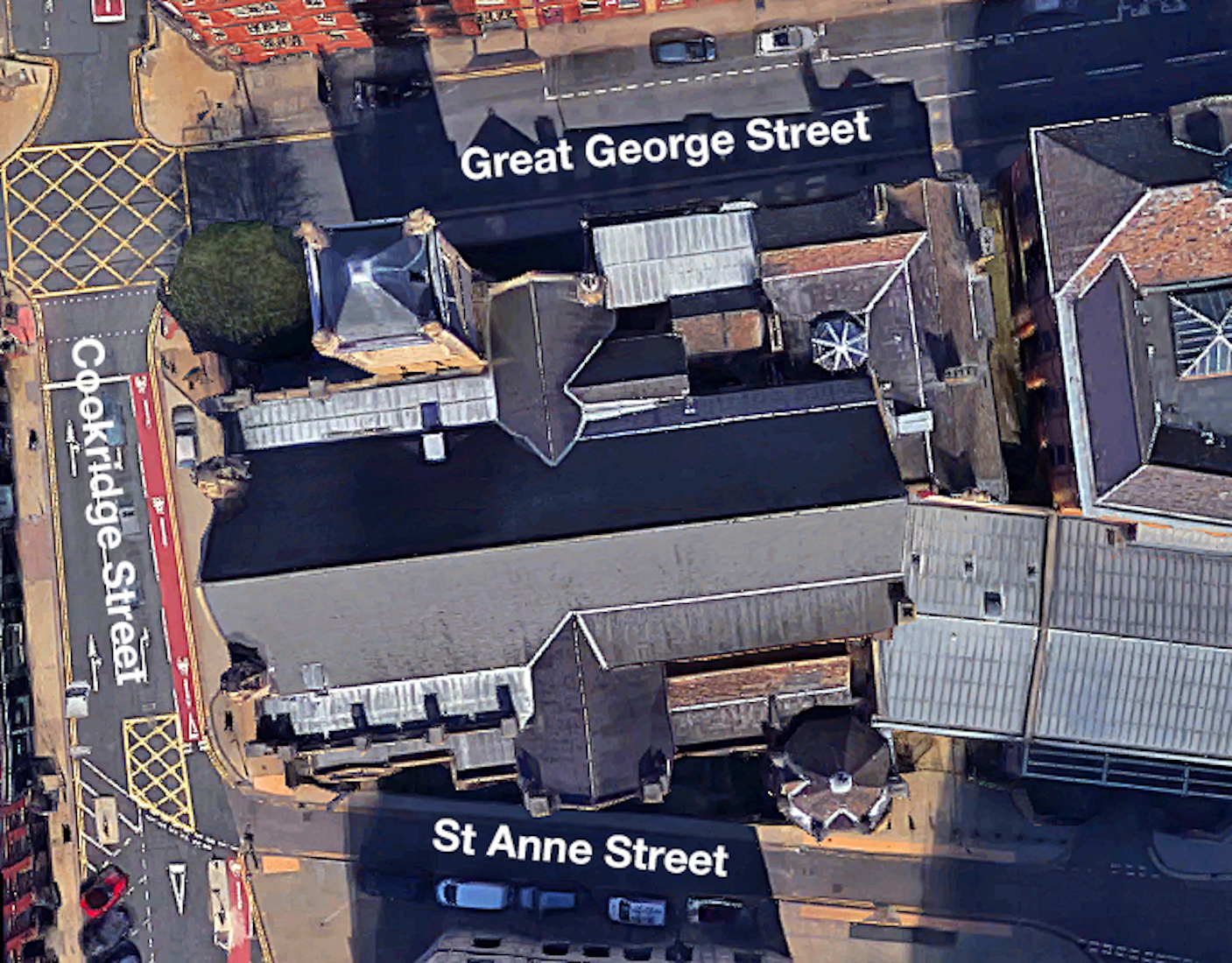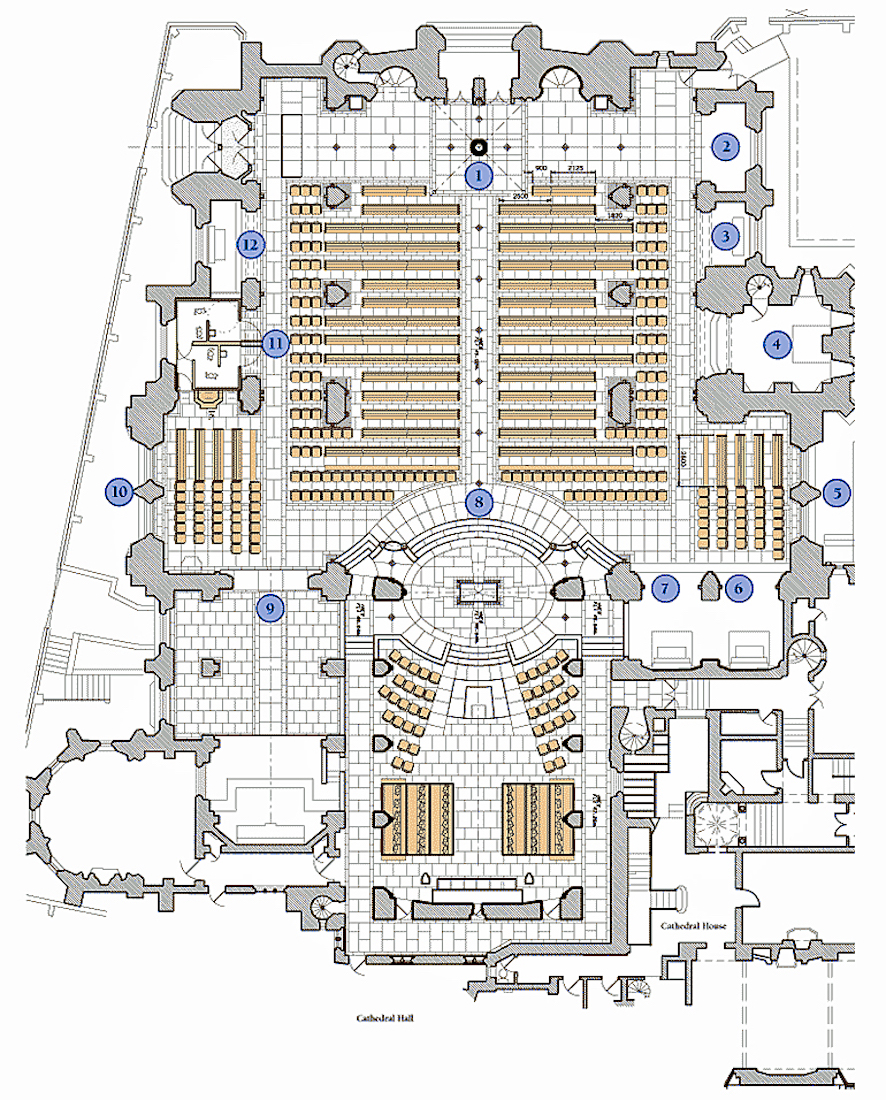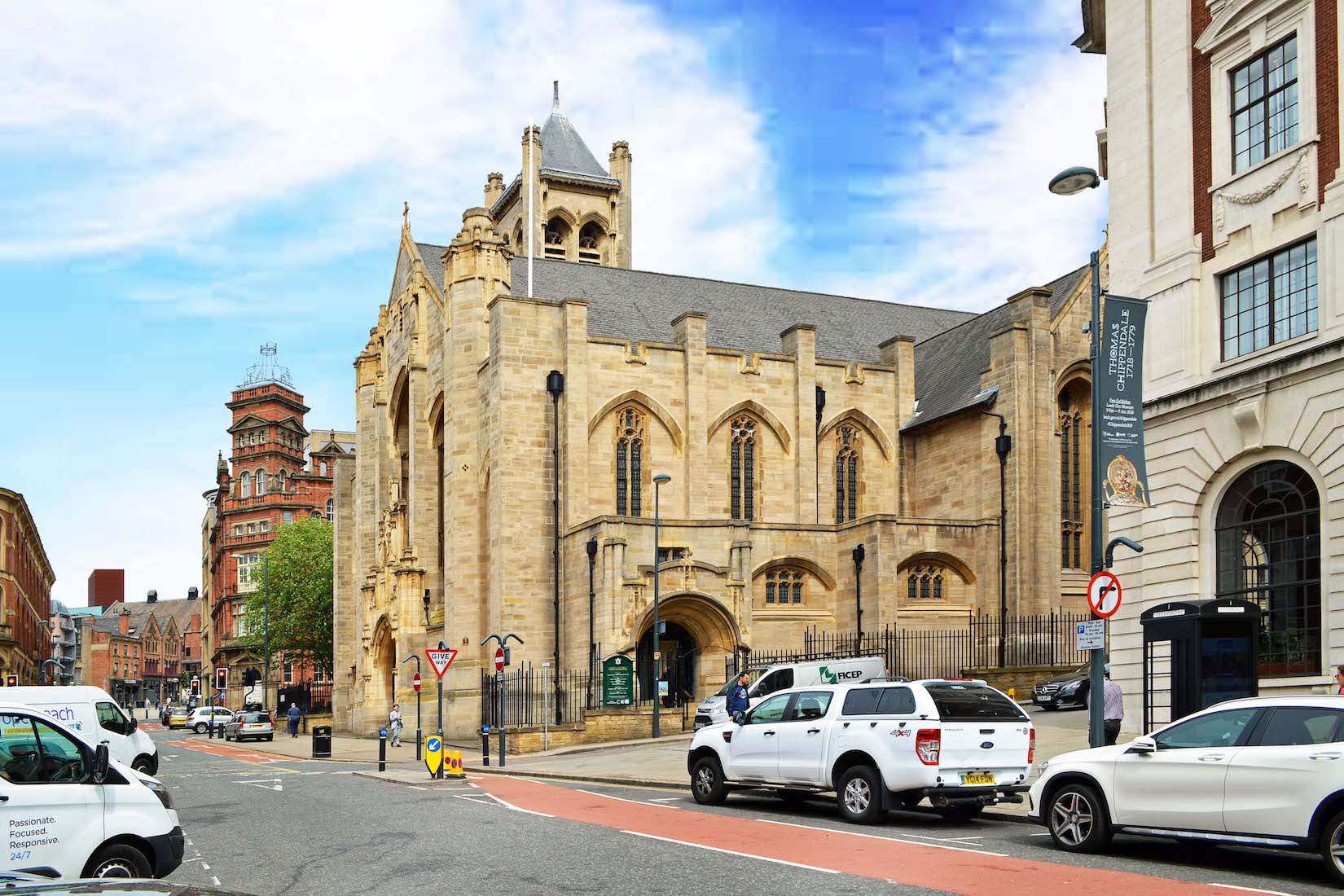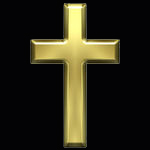LEEDS CATHEDRAL
ENGLAND CATHOLIC
PAUL SCOTT

SATELLITE VIEW
Leeds Cathedral is a city church on a rather cramped site bounded by streets on three sides and buildings to the east. It is basically cruciform in shape with a tower to the north and a chapter house to the south.
The sanctuary is very closely oriented to the geographical east, so we can easily identify our liturgical directions (for example East) with the georgraphical directions (for example east).
We shall explore the exterior of the Cathedral beginning in Cookridge Street at bottom left, and then enter the Cathedral via the small garden in the Northwest corner.

The Cathedral plan displayed here is from the Cathedral site
http://www.dioceseofleeds.org.uk/cathedral/cathedral_tour/floorplan.php
On the website it is interactive. Much of the textual information on this site is drawn from here. The list below has format:
Plan Number : Description : [Photo Number]
2. Sacred Heart Chapel (Shrine) [19]
4. War Memorial (base of tower) [26]
12. Yorkshire Martyrs Chapel [35]
I could not gain access to the Chapter House (bottom left). The nave is unusually wide in its design: this is to make the most of the limiting site.
As can be seen from the photo numbers, our route is slightly different from the Plan numbering. After exploring the exterior, we enter by the door at top left, and explore the nave in a clockwise direction. We then investigate the chapels 6, 7 and 9, and finally the sanctuary.
A brief history of the Cathedral is given below. However, if you want to begin your tour of the Cathedral immediately, tap / click on START . You can also access intermediate points in the tour by a tap / click on the links above.
NOTE ON MAGNIFYING IMAGES
With this website format the images are large enough for most purposes. If there is a need for greater magnification of an image, go to the identical photo on
https://www.flickr.com/photos/paulscottinfo/albums
and use Command - + (Mac) or Windows - + (Windows).
HISTORY
[Wikipedia]
Leeds Cathedral, formally the Cathedral Church of St Anne, commonly known as Saint Anne’s Cathedral, is the Roman Catholic Cathedral of the Roman Catholic Diocese of Leeds, and is the seat of the Roman Catholic Bishop of Leeds. It is in the city of Leeds, West Yorkshire. The city of Leeds does not have a Church of England cathedral, because though it is in the Anglican Diocese of Leeds, that diocese’s cathedrals are in Ripon, Wakefield and Bradford.
The original cathedral was located in St Anne’s Church in 1878, but that building was demolished around 1900. The current Cathedral building on Cookridge Street was completed in 1904, and was restored in 2006. The reredos of the old cathedral’s high altar was designed by Pugin in 1842 and moved to the Lady Chapel of the new Cathedral. The Cathedral is a Grade II* listed building.
Previous Cathedral
In 1786, Lady Lane Chapel was built, the first post-reformation Catholic place of worship in the city. In 1838, it was replaced by St Anne’s Church. At the time, there were only two places of Catholic worship in Leeds, St Patrick’s Church (which was built in 1831) and St Anne’s. The next church to be built in Leeds was Mount St Mary’s Church in Richmond Hill.
The earlier St Anne’s Roman Catholic Church, built in 1838 on the corner of the Headrow and Cookridge Street was granted cathedral status in 1878 upon the creation of the Diocese of Leeds. The cathedral’s life was short-lived as in 1899, Leeds Corporation pushed ahead with plans to widen The Headrow and develop it into a Boulevard style street. This meant that the cathedral was acquired by the enactment of a compulsory purchase order. Demolition started shortly after and the Leeds Permanent Building Society purchased the plot to build its head-office; the site is now The Light entertainment complex. Church officials considered several sites on which to build the second cathedral but after exhausting other options, the church accepted land offered to it by the corporation, directly adjacent to the previous church. Some architectural features of the original building were salvaged and reused in the new building and some can now be seen at the Castle-by-the-Sea Hotel in Scarborough, North Yorkshire, the former residence of the artist Atkinson Grimshaw who was the father of the first cathedral choir master, Arthur E. Grimshaw.
Current building
The current Cathedral was designed in the Arts and Crafts Gothic Revival style by John Henry Eastwood (1843–1913), a Leeds-born and London-based architect with previous experience in designing church buildings; much work was also carried out by his assistant, Sydney Kyffin Greenslade (1866–1955). The layout of the Cathedral incorporated no wings, in order to accommodate it on the small site. Building work began in the autumn of 1901 and the cathedral opened in 1904.
After renovation in the Cathedral (2005–2006) relics of English Catholic martyrs, Blessed Peter Snow and Ralph Grimston, were placed in the altar.
Building
The Cathedral is small in size due to its restricted site. The Cathedral has an aisled nave and chancel under a continuous roof with narrow transepts and chapels. There is a chapter house and presbytery. It is built of Weldon stone with Ketton stone details. The West front has a tall gable between large buttresses that end in Gothic turrets. The Western face has a large ornate crucifix sculpture. The Northern face has mock-Georgian elements to it, including leaded bay windows. The church has a small tower to the Northwest corner, from which the flag of the Vatican City is flown. The interior has a conventional layout, with rows of pews facing towards the altar, there are two rows of stone pillars set along each side. The ceiling has a barrelled shape, with only a faint apex.
https://en.wikipedia.org/wiki/Leeds_Cathedral



